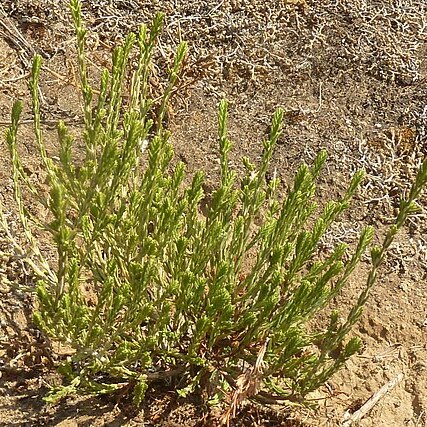Shrub, up to 3 m high; many stemmed with many short, slender branchlets. Leaves crowded, appressed or slightly diverging from stem; blade ovate to linear, 1.3-4.0 x 0.5 mm. Flowers: in terminal, 4-flowered clusters; bracts often keeled and subacute, usually thin and coloured, longitudinally veined, glabrous on back; stamens exserted; calyx with tube 3-5 mm long, creamy yellow to pink, red or brown; Sep.-Dec.
Shrub or dwarf shrub, 0.2-3.0 m high. Leaves: abaxial surface of young leaves glabrous. Bracts ovate to obovate, lamina villous on inside, glabrous on outside, obscurely ribbed on each side of main vein, thinly coriaceous, 4.0 x 0.9 mm. Hypanthium: neck tomentose, ± 0.8 mm long. Flowering time Oct.-Jan. Fruit an achene.
Calyx tube 3–5 mm long, flask-shaped, softly hairy within, pubescent outside except for the usually glabrous persistent base, circumscissile above the ovary; lobes 2–3 × c. 1.5 mm, obovate or oblong, scantily pubescent on the upper side, glabrous beneath.
Shrub, up to 1.5 m high. Inflorescence terminal, sub-capitulate, with 4 flowers. Bracts often keeled and subacute, usually thin and coloured, longitudinally veined, glabrous on back. Flowers creamy yellow to pink, red or brown.
Inflorescences terminal clusters, usually 4-flowered, surrounded by bracts and sometimes also with small bracteoles, those on short, sometimes numerous upper branchlets ± running together and forming compound inflorescences.
Leaves crowded, appressed or slightly diverging from the stem; lamina 1.3–4(5) × c. 0.5 mm, widest at the base, ovate to linear, glabrous beneath, compressed at the apex.
A compact or spreading sometimes many-stemmed shrub up to 3 m high, with numerous short slender branchlets, also reported as a small tree.
Bracts 4, 4–6 × 2–4 mm, ovate or obovate, often keeled and subacute, longitudinally veined, comose within, glabrous on the back.
Stems and branchlets closely tomentose or pubescent when young; bark greyish on older branches.
Ovary subsessile, sometimes hairy at apex; stigma reaching the throat of the tube.
Stamens exserted; anthers c. 1 mm long, oblong.
Flowers yellowish, pinkish or red.
Fruit dry.

